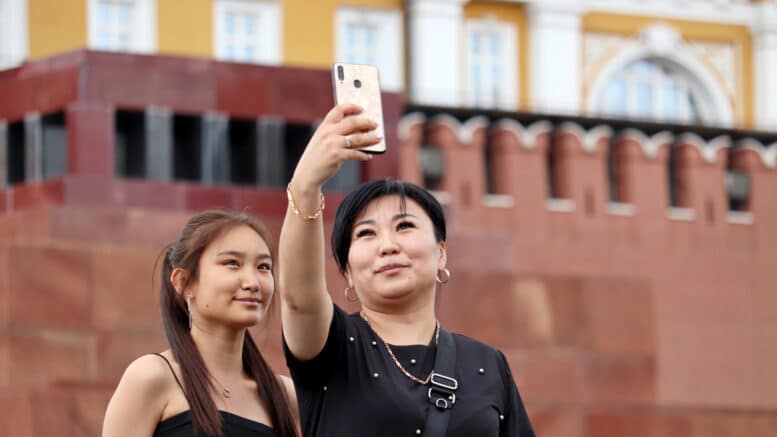Technology is constantly evolving, utilizing ever more bandwidth and making ever more connections between people and devices. Because of this, new cellular networks are needed to keep up with the growth.
Expectations are relatively high in Russia. A 2019 survey by GMA Intelligence found that 58% of Russians expect 5G networks to deliver improved mobile data speeds. Yevgeny Kovnir, the CEO of ANO Digital Economy, claimed that, “5G is needed to enable autonomous transport, and deploy VR/AR technologies that bring the quality of interaction between the human being and the world around them to a whole new level.” He went on to explain how a key advantage of 5G communications is its potential is to boost the overall Russian economy.
Elena Bunina, the CEO of Yandex, asserted that, “The entire country needs 5G networks to get to the next level of quality of communications. It is not just quantitative growth in terms of the amount of information being transmitted; it is a qualitative leap forward that is bound to completely change all internet-related industry.” She went on to talk about the exciting changes that 5G would bring to the transport industry.
The development of 5G networks will change the way humans communicate and live, with potential economic, commercial, and political repercussions. It is no surprise that governments and private companies alike are investing time and resources into the development of 5G networks. This article overviews Russia’s development of 5G, including its history, the complications it faces, and its future perspectives.
Emergence of 5G in Russia
The Russian telecommunications sector is controlled by the “big four” operators: Mobile TeleSystems (MTS), Megafon, Vimplecom (Beeline), and Rostelecom (Tele2). While fierce competition has led to low telecommunication prices in Russia, the four have been successful in working together to lobby for some issues like 5G development.
Russia’s Ministry of Digital Development is officially responsible for the Digital Economy National Project and introduction of 5G in Russia however, development has also been significantly affected by the Russian security apparatus, which includes the Ministry of Defense, the Federal Protective Service, and the Federal Security Service over national security concerns.
At the end of 2018, less than a third of Russia’s connection base was made of 4G. This base is the foundation for any potential 5G development. Russian operators have been increasingly investing in 4G and are expected to reach two thirds of total connection by 2023.
Notable 5G trials in Russia have included MTS’ 5G demonstration zones during the 2018 FIFA World Cup, and Rostelecom’s 5G pilot zone in Skolkovo, Russia, as well as Rostelecom’s trails with Ericsson (a Swedish based telecommunications company) to showcase 5G-controlled robotic restoration equipment at the State Hermitage Museum in St Petersburg.
2017’s Digital Economy of the Russian Federation was the first substantial development plan for 5G infrastructure in Russia. It and its related action plans outlined that a more detailed plan was to be drawn up by March 2019. September 2019 was marked as a deadline for the State Commission for Radio Frequencies to decide the frequency ranges to be allocated for 5G development. By the end of 2020, 5G pilot projects should have been initiated and, by the end of 2021, conditions for 5G mass implementation defined. With these deadline met, 5G networks would cover all Russian cities with more than one million inhabitants by 2024, using Russian-made technologies.
This plan was met with problems from the beginning. The draft of the more detailed plan from The Ministry for Digital Development was heavily criticized by other ministries. In December 2019, the Ministry for Digital Development adopted a revised draft despite fierce opposition from mobile operators. In March 2020, as a result of leadership transitions within the Russian government, the draft was sent back to the ministry for further elaboration with two crucial issues to resolve, discussed below.
Complications with the Development of 5G in Russia
Access to Frequencies
The first issue was access to radio frequencies. The Ministry of Defense declared in 2018 that it was unwilling to release the 3.4-3.8 GHz frequencies that were designated as base frequencies in the development plans and globally recognized as optimal for 5G. This is because important Russian military applications, such as radio relay systems, medium-range flight radars, and satellite communications, operate on this band. Further, securing the release of the 700 MHz band that is essential for expanding network coverage along transport routes, was problematic as it is currently used for television transmission, radio navigation, and aviation landing systems. Also, the Russian government is unlikely to unblock the 700 MHz band anytime soon since there are not plans to develop 5G outside large cities in the initial phase.
The plans also called for 4.4-4.99 GHz to be an auxiliary band, which the mobile operators agreed to. This is problematic because the Ministry of Defense later decided that 4.4-4.99 GHz would be the main band and largely blocked the mobile operators’ access to the 3.4-3.8 GHz band. Also, frequencies in the 4.4-4.99 GHz band are not prioritized by global telecommunication equipment producers, making it marginally more expensive for mobile operators in Russia.
In April 2019, the former Deputy Prime Minister of Digital Development asked President Putin to intervene in the disagreement. President Putin deferred to the powerful Security Council, who’s main concern is National Security. In 2019, it unsurprisingly decided in favor of the Ministry of Defense and, in May 2020, it rejected the major operators’ request to release the bands in only large Russian cities.
One expert opinion on the matter asserts that until the 700 MHz band is released for the Russian 5G network, the development of 5G networks in Russia and neighboring European countries will face difficulties due to the signals crossing borders and interfering with each other.
Network Operator Model
The draft includes three development scenarios based on studies by the Radio Scientific Research Institute (NIIR). In the first scenario, the ‘big four’ develop networks independently while sharing 10 to 15 percent of the infrastructure. In the second scenario, everything is the same except 50 to 70 percent of the infrastructure is shared. In the third scenario, there is one shared network developed by a single infrastructure operator.
The Ministry of Digital Development argues for the third scenario, claiming it would reduce overall costs, speed up implementation and provide equal access to resources. However, the Federal Antimonopoly Service argues that a single 5G network operator would lead to a monopolization of the network, causing higher prices and lower quality of service.
Import Substitution
China’s Huawei, Sweden’s Ericsson, and Finland’s Nokia are the three leading suppliers. In 2020, China’s Huawei came in first for imports of essential 5G network materials to Russia, while Sweden’s Ericsson came in second, and Finland’s Nokia, third. The ‘big four’ prefer to keep their equipment procurement diversified and therefore rely on all three suppliers. They oppose constraints on their choice of hardware and software supplier.
No Russian company has experience mass producing that kind of equipment. Initially, the Ministry of Industry, in line with Russia’s import substitution requirements, drew up a list of approved suppliers that included no Russian companies.
However, the Russian technology firm Rostec announced in 2019 that it would begin producing 5G equipment. Since then, the requirements have been altered to call for the exclusive use of Russian made equipment.
Operator and Supplier Issues
The operator and supplier issues seem have to been resolved in late 2020 when the Presidium of the Government Commission on Digital Development issued a new roadmap. Rostec will be responsible for creating the 5G communication equipment and Rostelecom for building the networks and developing services. From the federal budget, about 21.5 billion rubles will be allocated to the production of Russian communication equipment. To make time for Rostec to gear up its manufacturing of 5G equipment, the timeline of 5G introduction to Russia has been pushed back from 2021 to 2024.
The actual timeline may be slower. Igor Guryanov, General Director of Spectrum Management LLC, stated “Taking into account the announced plans for the readiness of domestic equipment, full-scale 5G networks are unlikely to appear before 2025. Some dedicated 5G networks without the baggage of already operating LTE and without the need to work in many bands at once may appear earlier.” Nonetheless, progress is happening.
The complication with radio frequencies has not been resolved. The Ministry of Defense and mobile operators are still at odds over which frequencies Russia’s 5G network should be developed on. Nonetheless, progress is happening. The mobile operators are conducting tests on frequencies outside of the 3.4-3.8 GHz and 700 GHz bands.
Developments in 2021 for Russia’s 5G Network
At the end of May, 2021, MTS launched a 5G network in St Petersburg that allowed operator subscribers to connect to unlimited and free 5G internet. It was the first 5G network for mass use, although it is only available to select MTS subscribers in certain locations within the city. The subscribers must have smartphones that are compatible with 5G networks in the 4.4-5.0 GHz band.
One new complication that arose this year was a first mass protest of 5G networks. In March 2021, Russian police broke up weeklong anti-5G protests in Yekaterinburg. Protesters occupied the construction site for a new 5G tower to prevent work, claiming the tower was unsafe and illegal. Russian authorities responded with a statement that the tower has state permits deeming it and its installation safe to the public.
In more positive news, in September, MTS and Huawei announced that the pilot 5G network in Moscow’s Dream Island amusement park achieved a data transfer rate of 5.6 Gbit/s from the base station to several smartphones operating in range. The tested multi-antenna solution from Huawei’s Massive MIMO technology (developed to help Russian operators use frequencies outside of the 700 MHz band) significantly increases network output and thus increases average data rates for a for a large number of users. According to a statement from MTS and Huawei, that is a record speed for Russia.
Solutions using Massive MIMO technology will be widespread during the construction of 5G networks in stadiums, concert venues, shopping and business centers, residential areas, and the transport industry, where it is necessary to ensure a high capacity and high-quality network.
Conclusion
As 5G continues to develop in Russia, new and promising opportunities will emerge. Russian consumers will increasingly be provided with the higher speeds they desire from 5G networks. Similarly, Russian enterprise will have the opportunity to deploy cutting edge technology.



